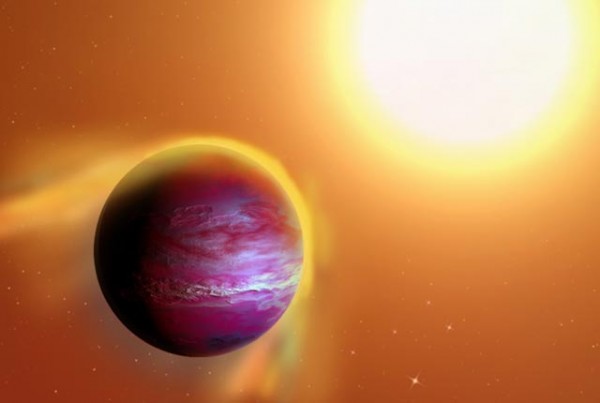This 'Baby Jupiter' is Being Ripped Apart by its Own Sun
| Ana Verayo | | Jun 11, 2016 04:17 AM EDT |
(Photo : A. Passwaters/Rice University) An artist’s impression of likely new giant planet PTFO8-8695 b, which is believed to orbit a star in the constellation Orion every 11 hours. Gravity from the newborn star appears to be pulling away the outer layers of the Jupiter-like planet.
Astronomers have detected a newborn "baby Jupiter" located at a distance of 1,100 light years away, making this exoplanet one of the youngest ever discovered at only 2 million years old. Earth is at 4.5 billion years old.
Like Us on Facebook
This new planet known as PTFO8-8695 b is not just newly formed, it is also slowly being torn and ripped apart by its own sun, as it orbits it every 11 hours.
Even if scientists call it as a "baby Jupiter" it possesses twice the mass of the real Jupiter in our solar system. In this new study, a team from Rice University is still deciphering the nature of this exoplanet, analyzing how much time does it have left before it dies and becomes completely obliterated since new findings reveal how this is the one of the youngest planets ever discovered.
According to astronomer Christopher Johns-Krull of Rice University, to date, it is still unknown what is the fate of this planet. This exoplanet most likely formed at a farther orbit from its host star and mysteriously migrated to a point where it is now being destroyed. This new evidence now confirms the existence of close orbiting planets near middle aged stars with stable orbits.
Apart from this, the team reveals how this planet is surrounded by a circumstellar hydrogen gas which indicates its young age. This young planet's hydrogen emissions are apparently as bright as its own star.
Johns-Krull adds, there is simply no other way how the planet's surface can produce this illuminating effect which means that the gas is now filling a larger region where the gravitational forces of the planet is no longer powerful enough to contain it. This led to its host star's gravity taking over where the gas is now falling into the star, slowly sucking it in and killing this planet.
The team of astronomers have already detected more than 3,300 exoplanets where the majority of them are orbiting middle aged stars. This newborn "baby Jupiter" however is the first evidence that such planets exist, at only a few million years old.
This new study is published in The Astrophysical Journal.
Tagsbaby jupiter, Exoplanets, young planet, baby Jupiter destroyed by star, youngest planet
©2015 Chinatopix All rights reserved. Do not reproduce without permission
EDITOR'S PICKS
-

Did the Trump administration just announce plans for a trade war with ‘hostile’ China and Russia?
-

US Senate passes Taiwan travel bill slammed by China
-

As Yan Sihong’s family grieves, here are other Chinese students who went missing abroad. Some have never been found
-

Beijing blasts Western critics who ‘smear China’ with the term sharp power
-

China Envoy Seeks to Defuse Tensions With U.S. as a Trade War Brews
-

Singapore's Deputy PM Provides Bitcoin Vote of Confidence Amid China's Blanket Bans
-

China warns investors over risks in overseas virtual currency trading
-

Chinese government most trustworthy: survey
-

Kashima Antlers On Course For Back-To-Back Titles
MOST POPULAR
LATEST NEWS
Zhou Yongkang: China's Former Security Chief Sentenced to Life in Prison

China's former Chief of the Ministry of Public Security, Zhou Yongkang, has been given a life sentence after he was found guilty of abusing his office, bribery and deliberately ... Full Article
TRENDING STORY

China Pork Prices Expected to Stabilize As The Supplies Recover

Elephone P9000 Smartphone is now on Sale on Amazon India

There's a Big Chance Cliffhangers Won't Still Be Resolved When Grey's Anatomy Season 13 Returns

Supreme Court Ruled on Samsung vs Apple Dispute for Patent Infringement

Microsoft Surface Pro 5 Rumors and Release Date: What is the Latest?










